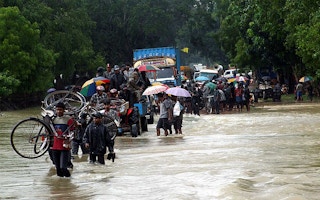In a bid to boost resilience in the face of disaster, some 200 cities this year say they will start using a new tool to develop strategies for curbing disaster losses from climate change and other risks.
The tool was released last week at the Global Platform for Risk Reduction summit held in Cancún, Mexico. Published by the UN Office for Disaster Risk Reduction, the Disaster Resilience Scorecard for Cities, as the tool is known, enables urban leaders to align their local disaster risk reduction efforts with an international accord known as the Sendai Framework for Disaster Risk Reduction.
That 2015 global agreement aims to cut disaster-related risk and the associated loss of lives and assets globally by 2030. Its near-term target is to substantially increase the number of local strategies for disaster risk reduction by 2020 — an issue that was at the forefront of the Cancún meet and something the scorecard aims to facilitate.
[See: Summit aims to ‘substantially increase’ local strategies on disaster risk]
The scorecard is an update of a previous version that was piloted in 35 cities, including Hong Kong, Geneva, Quito and Kisumu, Kenya. Companies AECOM and IBM, as well as the European Commission and USAID, were involved in the update.
Designed for local authorities to assess the resilience of their cities, guide local strategies around disaster risk reduction, and track their progress on implementation of the Sendai Framework, the scorecard can be used for two levels of assessment: preliminary and detailed.
The preliminary assessment is based on the UNISDR’s ‘10 essentials for making cities resilient’. These cover issues of governance and financial capacity, planning and disaster preparation, and how cities respond and recover in the wake of disaster. For example, one query posed by the scorecard asks of local leaders, “Is there a strategy or process in place for post-event recovery and reconstruction, including economic reboot, societal aspects, etc.?”
UNISDR suggests that the preliminary assessment, which has 47 questions, be used in a one- or two-day “city multi-stakeholder” workshop.
[See: U. N. increasingly looking to its urban agency on crisis response]
The detailed assessment gets further into the intricacies of what’s required for a local plan around reducing disaster risk and increasing city resilience.
It looks at things like putting in place organisational structures and identifying processes to understand and act on risk reduction, understanding current and future risks to inform decision-making, and strengthening financial capacity for resilience, among other things.
This assessment is a weightier task, comprised of 117 indicators. To complete it, the UNISDR suggests a multi-stakeholder endeavor that may last up to four months. The outcomes of this process could then form the basis of a “detailed city resilience action plan.”
UNISDR notes that most cities will likely not score above 50 per cent on the scorecard, since it gives an “aspirational definition” of disaster resilience. But the objective is to “guide cities toward improved disaster risk reduction.”
The agency also emphasises that strengthening resilience is a collaborative effort. And local governments should consult with relevant entities that control components of disaster resilience outside local governments’ control, such as private utility companies and provincial governments, when using the scorecard.
Likewise, it advises local governments to consult with citizen groups to “improve the validity” of their results.
This story was published with permission from Citiscope, a nonprofit news outlet that covers innovations in cities around the world. More at Citiscope.org.

















